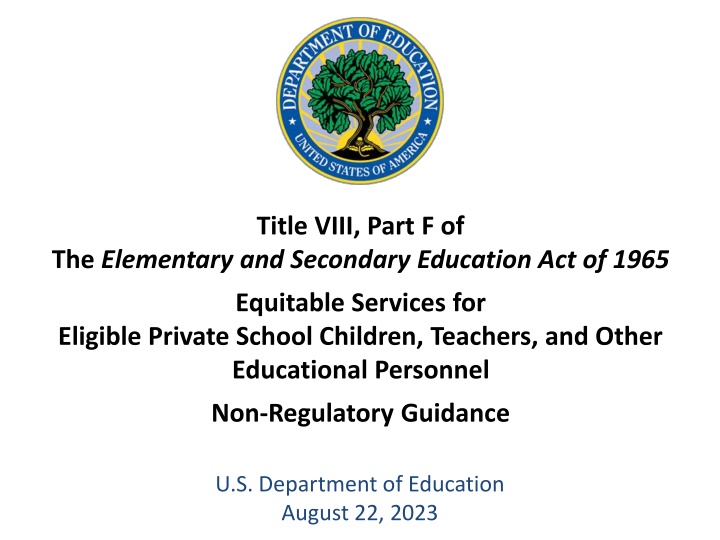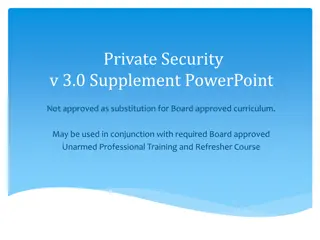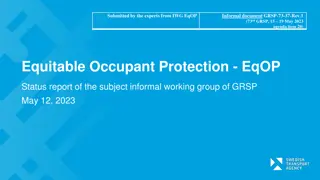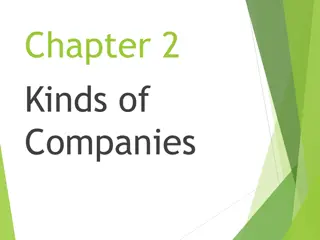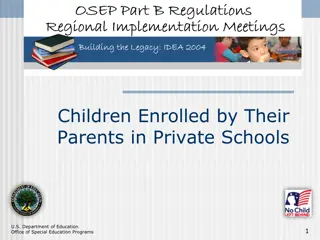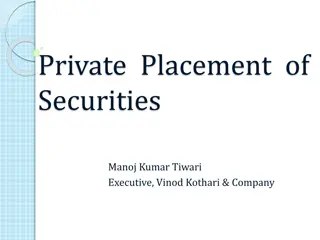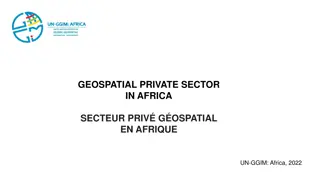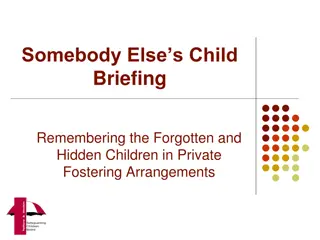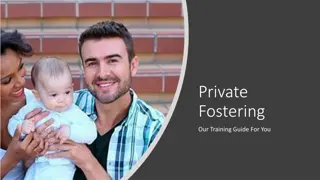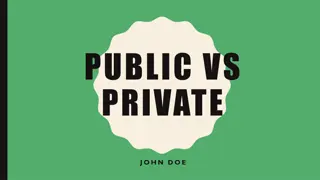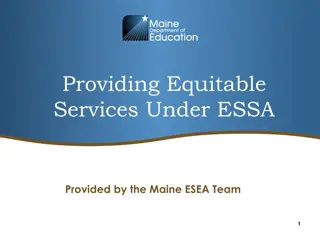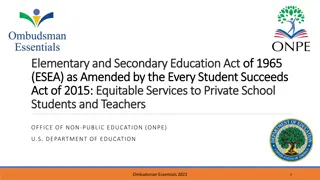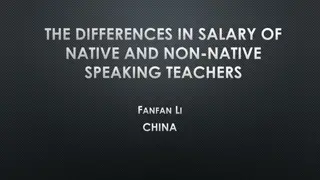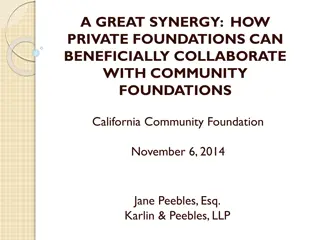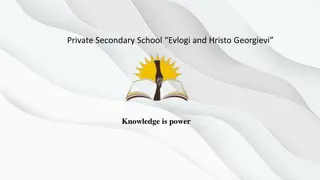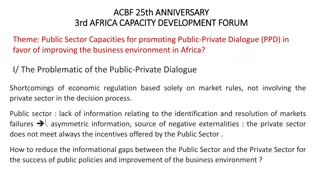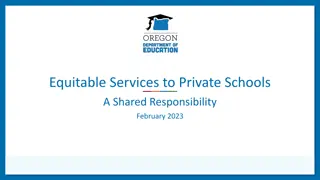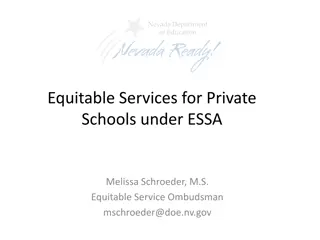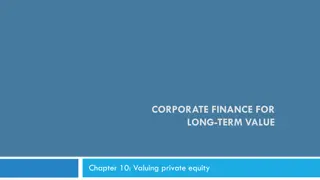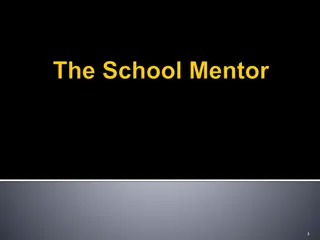Equitable Services for Private School Children and Teachers
The Elementary and Secondary Education Act of 1965, specifically Title VIII, Part F, outlines the provision of equitable services for eligible private school children, teachers, and other educational personnel. This non-regulatory guidance emphasizes the importance of ensuring fairness and support for private school stakeholders under various ESEA programs.
Download Presentation

Please find below an Image/Link to download the presentation.
The content on the website is provided AS IS for your information and personal use only. It may not be sold, licensed, or shared on other websites without obtaining consent from the author.If you encounter any issues during the download, it is possible that the publisher has removed the file from their server.
You are allowed to download the files provided on this website for personal or commercial use, subject to the condition that they are used lawfully. All files are the property of their respective owners.
The content on the website is provided AS IS for your information and personal use only. It may not be sold, licensed, or shared on other websites without obtaining consent from the author.
E N D
Presentation Transcript
Title VIII, Part F of The Elementary and Secondary Education Act of 1965 Equitable Services for Eligible Private School Children, Teachers, and Other Educational Personnel Non-Regulatory Guidance U.S. Department of Education August 22, 2023
Agenda Introductions Overview of Title VIII Non-Regulatory Guidance 2
Introduction Office of Non-Public Education Office of Elementary and Secondary Education Migrant Education School Support and Accountability Safe and Supportive Schools Disaster Recovery Unit Office of the General Counsel 3
Elementary and Secondary Education Act (ESEA) Since the passage of the ESEA in 1965, local educational agencies (LEAs) have been required to provide equitable services to private school students, teachers, and, in some cases, other education personnel and parents under a number of the ESEA programs. 4
ESEA Title VIII Non-Regulatory Guidance Title VIII, Part F of the Elementary and Secondary Education Act of 1965 Equitable Serviced for Eligible Private School Children, Teachers, and Educational Personnel Non-Regulatory Guidance July 17, 2023 https://www2.ed.gov/about/inits/ed/non-public- education/files/esea-titleviii-guidance-2023.pdf 5
ESEA Title VIII: General Requirements Allocations and Expenditures Consultation Delivery of Equitable Services State Ombudsman Complaints, State Provision of Services, and Bypass Other ESEA Requirements Related to Private Schools 6
ESEA Title VIII: Covered Programs Title I, Part C Education of Migratory Children Title II, Part A - Supporting Effective Instruction Title III, Part A - English Language Acquisition, Language Enhancement, and Academic Achievement Title IV, Part A - Student Support and Academic Enrichment Grants Title IV, Part B Nita M. Lowey 21st Century Community Learning Centers Title IV, Part F - Project School Emergency Response to Violence (Project SERV) 7
ESEA Title VIII Non-Regulatory Guidance Section A Consultation Definitions Responsible Party Identifying appropriate private school officials Timing Topics for discussion Strategies for effective consultation Goal of Agreement Documentation 8
Consultation Cycle A-13 Written Affirmation of Consultation Required A-11 Needs of Private School Students and Teachers Pooling of Funds A-9 Amount of Funds Available for Services and How the Amount Is Determined Size and Scope of Services Providing Services Directly or Via Another Entity How, Where, When and By Whom Services Are Provided How and When Decisions are Made Use of 3rd Party Provider and Written Explanation for Not Using 3rd Party Provider Assessment of Services 9
Goal of Agreement A-12. What is entailed in achieving the goal of agreement between an LEA and appropriate private school officials as required by section 8501(c)(1)? The goal of reaching agreement (ESEA section 8501(c)(1)) between an LEA and appropriate private school officials is predicated on the good faith efforts of all parties to reach agreement regarding the provision of equitable services. Meaningful consultation that results in agreement begins well before the decisions are made or services are implemented and provides a genuine opportunity for all parties to express their views, to have their views given serious, due consideration, and to discuss viable options for ensuring equitable participation of eligible private school children and educators. In the event of disagreement during the consultation process, an LEA and/or the appropriate private school officials may wish to contact the State ombudsman to help facilitate agreement. 10
ESEA Title VIII Non-Regulatory Guidance Section B Allocations and Expenditures Allocations Administrative and Other Expenses Timeframe for Obligations Notice of Allocations Transferability 11
Allocations B-1. How does an LEA determine the equitable share of funds for covered ESEA programs? Many LEAs calculate equal expenditures solely on the basis of the relative enrollments of public and private school children, or, as applicable, eligible public and private school children, on the permissible assumption that these numbers also accurately reflect the relative needs of children and educators in public and private schools. For programs such as Title III, Part A, which limit services to a specific group of children, an LEA would use the number of eligible children in the defined group enrolled in both public and private schools. However, it is permissible for an LEA to use other factors relating to educational need and not base equal expenditures only on relative enrollments. 12
Allocations Pooling Transferability B-4. B-6. B-17. B-18. Timeframe for Obligations and Carryover B-9. B-12. 13
ESEA Title VIII Non-Regulatory Guidance Section C Delivery of Equitable Services Eligibility Characteristics of Services Timing Location Public Control of Funds Use of Contracts 14
Public Control of Funds C-16. Must an LEA maintain control of program funds? Yes. An LEA must always maintain control of program funds as well as title to all materials, equipment, and property purchased with Federal funds. (ESEA section 8501(d)(1)). For programs for which an SEA must provide equitable services with State-level program funds (i.e., Title II, Part A and Title IV, Part A), the SEA must maintain control of funds in a similar manner. 15
Allowable Uses of Funds May private school officials order or purchase materials and supplies needed for a covered ESEA program and be reimbursed by an LEA? May an LEA pay for out-of-State professional development for private school educators? May an LEA pay fees, hotel, travel, and meal expenses for private school educators to attend a conference? May ESEA funds be used to pay stipends to private school staff who participate in services and activities funded by covered ESEA programs? Must eligible private school children and educators participate in the same programs that an LEA provides for public school children and educators? May an LEA establish a blanket rule that precludes eligible private school children or educators from receiving certain services authorized by the ESEA? 16
Service Providers C-22. May an LEA use a third-party contractor to provide equitable services? C-23. May an LEA or a third-party contractor employ a private school teacher to provide services under a covered ESEA program to eligible private school children and educators? C-24. May an LEA contract with a religious organization to provide equitable services? C-25. What does it mean for a contractor to be independent of a private school in the provision of equitable services? 17
ESEA Title VIII Non-Regulatory Guidance Section D Ombudsman Role and Responsibility Monitoring and Enforcement Who May Serve Funds to Support the Ombudsman 18
ESEA Title VIII Non-Regulatory Guidance Section E Complaints, State Provision of Services, and Bypass Formal Complaints Appeals Circumstances for State Provision of Services Bypass 19
Formal Complaint E-1. What information must a formal written complaint to an SEA include? A formal written complaint must include: A statement that an LEA has violated a statutory or regulatory requirement applicable to the provision of equitable services under a covered ESEA program; The facts on which the statement is based and the specific statutory or regulatory requirement(s) allegedly violated; and The signature of the complainant. (34 C.F.R. 299.13). 20
ESEA Title VIII Non-Regulatory Guidance Section F Other ESEA Requirements Related to Private Schools Recipient Status Military Recruiter Requirements Family Educational Rights and Privacy Act (FERPA) School Choice 21
Recipient Status F-2. Does receiving equitable services under a covered ESEA program make a private school a recipient of Federal financial assistance ? No. A private school is not a recipient of Federal financial assistance by virtue of its children or educators receiving equitable services under a covered ESEA program. 22
School Choice F-5. Does a private school child s participation in a Federal or State private school choice program affect that private school child s eligibility for ESEA equitable services? No. Participation in a Federal or State private school choice program does not affect a private school child s eligibility for ESEA equitable services. 23
TITLE VIII COVERED PROGRAMS 24
Title I, Part C Education of Migratory Children Section G Purpose Entities responsible for implementing equitable services Eligibility Comprehensive Needs Assessments AllowableActivities 25
Title II, Part A Supporting Effective Instruction Section H Purpose Eligibility Entities responsible for implementing equitable services State-level equitable services AllowableActivities 26
Title III, Part A English Language Acquisition Section I Purpose Eligibility Entities responsible for implementing equitable services State-level equitable services Allowable activities Teacher qualifications 27
Title IV, Part A Student Support and Academic Enrichment Grants Section J Purpose State-level equitable services 20% distribution requirement Allowable activities 28
Title IV, Part A Stronger Connections Grant Program Authorized under the Bipartisan Safer Communities Act (BSCA) of 2022 Provides additional funding for SEAs to competitively award subgrants to high-need LEAs to establish safer and healthier learning environments, and to prevent and respond to acts of bullying, violence, and hate that impact our school communities at individual and systemic levels, among other programs and activities. Funds are to be used for allowable activities under ESEA section 4108 Title VIII equitable services provisions apply https://oese.ed.gov/bipartisan-safer-communities-act/ 29
Title IV, Part B Nita M. Lowey 21st Century Community Learning Centers Section K Purpose Entities eligible to apply for a 21st CCLC grant Targeting Determining equitable share Consultation Allowable Activities 30
Title IV, Part F, Subpart 3 Project School Emergency Response to Violence Section L Purpose Entities eligible to apply for a Project SERV grant Eligible events Allowable activities Consultation Determining equitable share 31
Contacts Office of Non-Public Education onpe@ed.gov or 202-401-1365 https://www2.ed.gov/about/inits/ed/non-public-education/index.html Ombudsman Directory https://www2.ed.gov/about/inits/ed/non-public-education/ombudsman-directory.html Office of Elementary and Secondary Education https://oese.ed.gov/ School Support and Accountability Title II, Part A Title III, Part A Title IV, Part B Migrant Education Title I, Part C Safe and Supportive Schools Title IV, Part A Project SERV Disaster Recovery Unit Project SERV OESE.titleii-a@ed.gov OESE.titleiii-a@ed.gov 21stCCLC@ed.gov migrant.education@ed.gov OESE.titleiv-a@ed.gov Hamed.Negron-Perez@ed.gov Maria.Rowan@ed.gov 32
